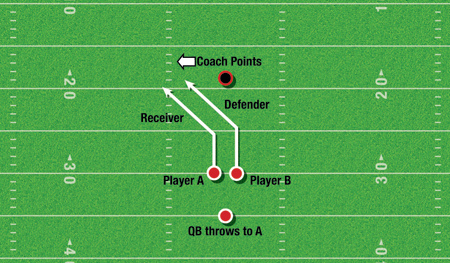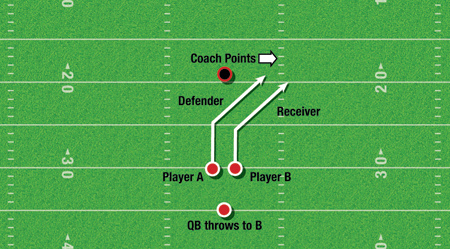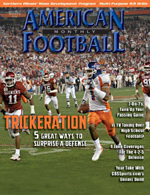7-On-7’s: Tune Up Your Passing Game
by: Glenn R. Swift©
More from this issue
While 7-on-7 competitions have been around for nearly 30 years, it’s only in the last seven or eight years that this concept has exploded. The growth of the 7-on-7 competition is a direct reflection of the growth of the spread offense. Today, more and more high schools and colleges are using the spread, and players and coaches see the value of 7-on-7 tournaments and competitions as ways to hone passing skills.
The events match skilled players against each other. Usually played on a 40-yard field plus an end zone, there are no running plays and the quarterback must throw a pass on every play.The quarterback has four seconds to release the ball or it is blown dead. There is no rushing the quarterback nor crossing the line of scrimmage until after a pass is thrown.
Bob Sphire, the Head Coach at North Gwinett High School (GA), has seen changes in 7-on-7 competition from the mid-80’s to today. “My coaching roots go back to the University of Louisville when Howard Schnellenberger was coach,” said Sphire. “We played a full 100-yard field and used the four-second count even back then to signify a sack just as we do now. The game has evolved to a half-field game with the rules of either needing to gain 15 yards or 20, depending on the tournament. The game has evolved from primarily college tournaments to high school events run by high school staffs.”
Sphire believes the increase in high school competitions is because of a change in the development of players. “The college 7 on 7’s seemed to be more about recruiting rather than competition,” said Sphire. “When the high schools started hosting their own, the emphasis was placed more on each team developing their players and preparing for the upcoming season.”
Summer camps are also thriving with 7-on-7 instruction and team competition. Ed Lamb, the head coach at Southern Utah University, has seen the dramatic growth of 7- on-7’s in the mountain west. “Sometimes things take a little longer to get to our part of the country but over the last few years its popularity has grown dramatically,” said Lamb. “So SUU is including 7-on-7 competitions among the spring and summer camps for both middle school and high school players. These competitions were non-existent here five years ago.”
In the last five years, the number of 7-on-7 competitions has doubled. Hoover High School in Alabama has an annual Southeast Select 7-on-7 National Tournament and Sphire’s school, North Gwinett, hosts a tournament each June. “This year we expect to have a number of states represented,” said Sphire. “We’re considering reaching out to include a school like Don Bosco from New Jersey so schools from outside the Southeast are represented.
Developing Skill Players
Florida Atlantic University Head Coach Howard Schnellenberger feels that many positives can be gained from 7-on-7 competitions. “7-on-7 is an opportunity to perfect the passing game during the down time that colleges and high schools have in the summer months,” said Schnellenberger. “7-on-7 camps are successful because you are honing skills of participants at a speed and level that ensures against injuries. With the limited amount of time collegiate coaches can spend in practice, 7-on-7 allows players to get passing game practice and experience that would take nearly a full season of practice to acquire.”
From the high school perspective, 7-on-7 can be a valuable tool as well. According to Bill Powers, Head Coach at Jupiter Christian High School (FL), which finished second in the 2008 Adidas National 7-on-7 Tournament, “Not only does it give quarterbacks, receivers, linebackers and cornerbacks the chance to sharpen their skills,” said Powers, “it gives coaches a chance to work with returning players and attract new ones in what might pass for the off-season.”
Powers has a favorite drill that he uses to help receivers, defensive backs, and the quarterback. Two players line up next to each other five yards in front of the QB. The coach is ten yards down the field from the two players. On the coach’s command, both players run full speed towards the coach. When they get about seven yards downfield running hip-to-hip, the coach points right or left. The way he points determines who the receiver is and the other player becomes the defender. The receiver then runs a post pattern and the other player covers the post as the QB throws to the receiver (See Diagrams 1 and 2).


Sphire feels there are many intangibles that benefit both players and coaches. “Besides developing individual skills and both offensive and defensive schemes, it places your players in a competitive setting for the fall season,” said Sphire. “You can also tinker with some concepts and coverages for your team to evaluate whether these ideas fit your personnel. The other intangible is developing more team unity as you travel and compete together.”
Bruce Reynolds, who won seven Delaware State Division I High School Championships and is a two-time High School State Coach of the Year, feels that quarterbacks, in particular can benefit greatly from 7-on-7 competitions. “7-on-7 rules demand that the quarterback must throw to a receiver within 4 seconds. A tip for all coaches and players would be to time all practice throwing drills. The obvious plan is that the quarterback learns to read, set his feet, and throw within a narrow time frame.”
The basic drills for 7-on-7 are identical to those of regular football. “Quarterback snap drills, passing drills, footwork drills, and mechanical drills are all important,” said Reynolds. “Equally important are pattern receiving drills, catching drills, after the catch drills, and proper ball holding techniques.”
Recruiting Advantages
Reynolds believes there are numerous recruiting advantages to 7-on-7 competitions. “7-on-7 allows scouts to observe skill players on more occasions,” said Reynolds. “It also allows for the scout to see the players perfecting their skill-set more times than they would during regular season game conditions. Also, the players benefit from the extra work, which allows them to enhance their recruitability.”
Because of the limitations of scouting a player during the regular season, 7-on-7’s give a recruiter time to watch a specific player in depth. “A college recruiter who has his eye on, say, a specific WR might get a chance to see that receiver catch 20 passes in a 7-on-7,” said Bill Powers. “That’s not going to happen in a regular game.”
The actual camps themselves also help college coaches make their recruiting decisions for the following year. “You get to watch the competitions and get to know the coaches and players personally,” said Schnellenberger. “It helps you make preliminary decisions in the summer before the players’ senior year.”
National/Regional
Competition
The NFL will be sponsoring 7-on-7 competitions in selected cities where they have teams this spring and summer. A total of 20 of the 32 NFL teams are participating in five-day camps called the High School Player Development Program which include 7-on-7 competitions. “We expect a total of 25,000 high school athletes to be a part of our HSPD program this spring and summer,” said Jerry Horowitz, Director of the NFL’s High School Development Program. The National Guard will be partnering with the NFL and speaking with both athletes and coaches about personal development and community service at each site. “We want all of the athletes in this program to be successful,” said Lt. Col. William Dones, the head of National Guard advertising. “There are many opportunities for these kids outside of football and we want to present options for them.” The NFL 7-on-7 competitions conclude with a national championship scheduled to take place in Tampa in early July. More information can be obtained by going to www.nflyouthpd.com.
According to Bill Powers, the trend is towards more regional competitions. “You’ll see many of these tournaments scattered throughout the South in May and June,” said Powers. “You could really play in different competitions each week during the spring and early summer.”
7-on-7 competitions are clearly here to stay. “The ability to grow your teams’ offensive skills and give your skilled players competition is paramount to your teams fall success,” said Schnellenberger. “It’s a great way of improving your passing game in a competitive environment. Similarly, giving your program exposure from a recruiting standpoint is what every high school wants.”







